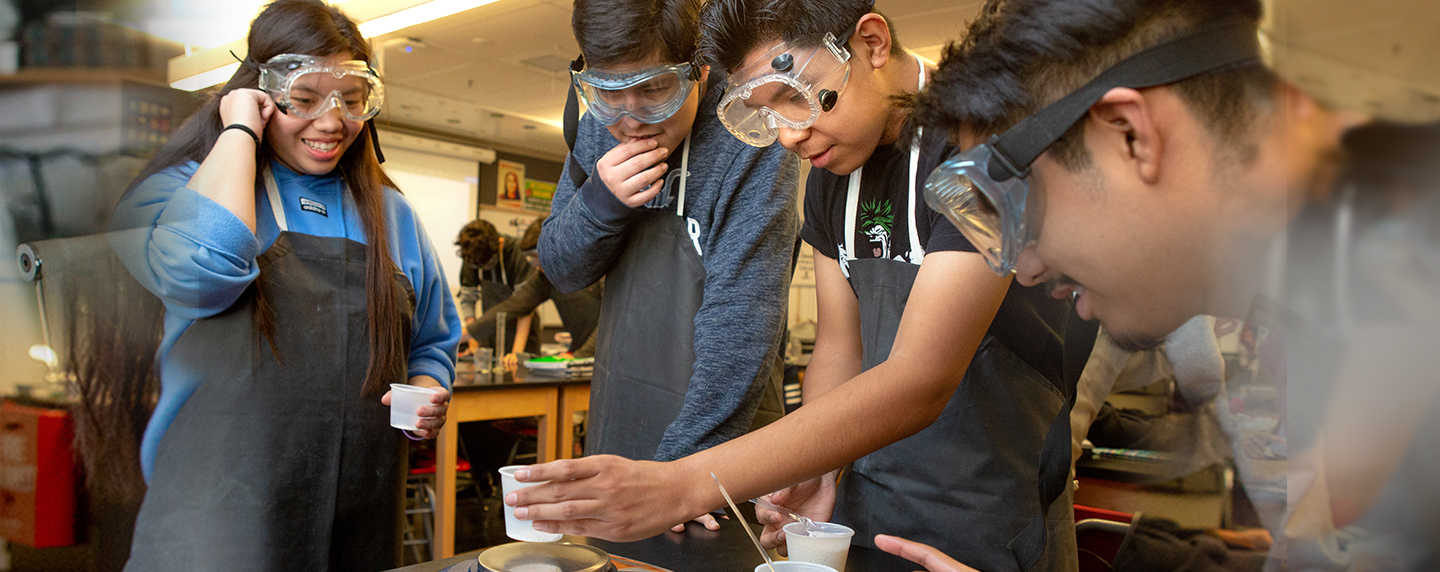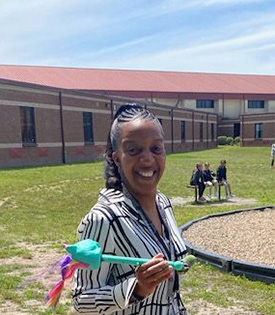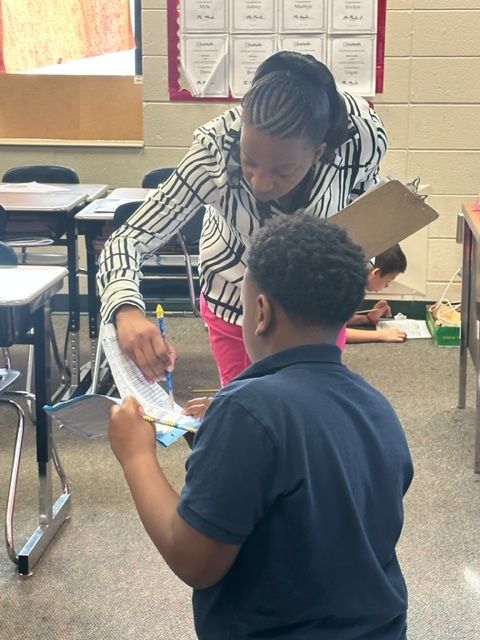
Stories of Impact
Back to In Action / Natalie Mondesir, Educator
Natalie Mondesir
Teacher, Liberty Elementary School, Midway, Georgia
Natalie Mondesir has taught math, science, social studies, and language arts to hundreds of fourth-graders in rural Georgia over the last 13 years. Through Invention Education, she infuses each subject — as well as her classroom — with a sense of wonderment and creativity, continuously asking her students to observe the world around them, and to develop solutions to the problems that they see.

Natalie Mondesir
The key to my success has been my own enthusiasm.
Did you always want to be an educator?
I was five when I got my calling for teaching. I remember at the end of the school year I would ask if I could take home the Teacher Edition textbooks. It didn’t matter what grade the books were from, I would take them home. I had a stack of them. I was that kid.
At first, I used them to teach my stuffed animals. And then I started teaching my younger brother and sister. Every summer they had to endure at least three hours of being taught with worksheets. My mom would make copies for me. So by the time they were back to school, they were prepared.
What inspires you?
I’m a proud mother of two sons. My oldest is 20 and my baby turns 18 this month. He’ll also be graduating high school. He’s one of my inspirations for being a teacher because I consider him twice exceptional. He was born with hydrocephalus, which is fluid on the brain. And they weren’t expecting much from him. But right now, he’s in the top 30 of his class.
He’s the only person I know that when he’s sick, he’s still contacting the teachers, saying, “I’ll still get my work done.” He’s one of the main reasons I became a teacher.
How would you describe your relationship with your students?
I tell them once they’re in my classroom, they’ll always be my babies. So far I’m up to about 400 babies. And when they get older they come back to see me.
I have one student who visits me every year. The first time she came back — she was a sophomore or junior by then — she stopped by my door and asked, “Do you remember me?” I said, “Arianna, of course I remember you. You’re my baby.” And she looked at me and started to cry.
What does teaching feel like for you?
For me, it’s fun. I like sharing my knowledge and sharing my excitement and joy. The ultimate teacher high for me is when I teach the subjects and then show students how it applies in the real world. So when they’re doing an invention and they come up with ideas, I let them see if they can figure out the connections, like where math fits in, or science, or social studies.

My classroom is a safe space to air out ideas.
How did you come to use Invention Education in your classroom?
The first year I did STEM, which was my third year of teaching fourth grade, my principal wanted to start up an initiative where we had one STEM class per grade level, from second to fifth grade, and no one wanted to do it in fourth grade. I was like, “I’ll do it.”
And that’s how I started. I had a small class. I had 16 kids but needed 20 for the funding, so I had to recruit some students. That was the only year I had to recruit.
How did that go?
The first year I did STEM, which was my third year of teaching fourth grade, my principal wanted to start up an initiative where we had one STEM class per grade level, from second to fifth grade, and no one wanted to do it in fourth grade. I was like, “I’ll do it.”
And that’s how I started. I had a small class. I had 16 kids but needed 20 for the funding, so I had to recruit some students. That was the only year I had to recruit.
What's your key to getting kids to engage with their learning?
The key to my success has been my own enthusiasm. If the teacher is excited, that’s going to make the kids excited. I also joke around with my kids, the same way I do at home. I treat them like my own children. I can be a strict disciplinarian, but my students know that as long as they do what they’re supposed to do, it’s smooth sailing.
They know the norms of the class and what’s expected when I’m not there. I’m also very much their advocate. I tell them I love them to pieces but don’t disappoint me. And they don’t want to disappoint. They keep each other accountable too because they don’t want somebody else to ruin it for them.
I tell my students all the time, “Yes, I’m the teacher. And no, I’m not supposed to know everything.” The point of being a teacher and being smart is to know where to find information. Your brain can only store so much. But if you know where to go to get it, then that makes you smart.
My classroom is a safe space to air out ideas. In my opinion, the best inventions come from regular people. That’s what I tell my students. I say, “Don’t let anybody tell you differently. You keep inventing.” Also: When I teach, we sit on the floor, because it creates the mood of us just having a conversation.

Why do you think it’s important to teach science, invention, and innovation, especially to kids living in rural areas?
The main reason is, they’re not exposed to it. Many of my students haven’t had a lot of experiences going to different places and seeing different things. I still have a lot of kids who have never been to Savannah, which is a 20 mile ride.
They think that you have to be a genius to come up with an invention. I tell them, “No.” I say, “Do you have a brain? Do you have an idea? Then you could be an inventor. Anybody could be an inventor. And you won’t know unless you try. So let’s try.”
So we’ve been working on building them up to trying, and exposing them to different things. I said, what problems do you have in your house? I said, start off small — what problems do you have in the classroom? Look around. There’s problems everywhere. I said, “It’s up to you to find and see if you can fix the problem.”
For kids who aren't drawn to STEM, how do you get them into it?
I observe, and take time to get to know them. I don’t usually start anything too big until we’ve been in school a month or two, because that gives me time to see what they like.
And we’ll find something that works to their talent. We make video games, for example. Everyone in my class likes video games! But there are different types of video games, so I tell them, “You work on the type that works best for you.” And then I’ll play it.
What's an example of a student who identified a problem and had a solution?
One of my students is very passionate about homeless children. So this student wanted to make a blanket that was insulated and used technology to help regulate temperature — to warm the baby up in the winter and cool them down in the summer. In their research, they learned things like the blanket couldn’t get too hot, and it had to be water resistant. The idea evolved into something they could make for pets too.
What’s the value for you of being part of the InventEd network?
It’s magical, in that I haven’t been around a lot of people like me, people who are just as passionate as I am. Just as silly as I am, just as inventive as I am. I’m like, “Oh, I’m not crazy. This is actually a thing!”
I’m a very shy person in nature. I don’t necessarily go out and talk to people. But when I was at the InventEd convening, I was just going up to people and talking to them. I never do that. It was like an out-of-body experience watching myself. When I came back to my school, I was filled with gusto.
Why is technology so important in the classroom?
It’s the way of the future. In addition to the 3D printers, I have robots, squishy circuits, and more. I’m trying to give my kids the upper hand that the kids in Atlanta have — they’re very rich in technology and exposed to different resources, and I want my kids to have the same opportunities.
When we use technology in my classroom, it’s not just getting on the iPad and playing a game. My students are designing, using augmented reality, making movies, and learning how to put their voices in soundtracks to create songs.
Do you have to get special funding to get some of these robots and equipment?
Yes, I received two grants from Bright Ideas, the local co-op that provides grants of $2,000 for teachers. I received two of those and I’ve been fortunate to have admin that put money aside for STEM, so I was able to get funding that way, and a portion of it I bought myself.
When I say, “I would do anything for my kids,” if that means buying something for them, I’m buying it.
Are there any teachers who made a lasting impression on you or helped shape who you are as a teacher?
There are tons who have helped me. My fourth grade teacher, Mrs. Katz, made me feel comfortable as a shy kid. My sixth and seventh grade teacher, Ms. Garlock, brought education to life for me: She’d read us Willy Wonka and the Chocolate Factory, and give us candy at each scene. And my ELA teacher, Ms. Cook, took us to museums and taught me about African and Japanese mythology. She did things outside the box, and she made me want to be a teacher who did things outside the box too.
I also want to showcase three teachers at my school now who help me continue to be the best I can be: One was Kelly Green, our gifted and talented teacher who passed away last year from breast cancer — she taught me that laughter is good for the soul. There’s also Dr. Kelly, who is so passionate, she’ll do anything for anybody, and is a mother to everyone. Finally my teacher bestie, Ms. Keva Wallace, who teaches fifth grade. She helps me be better, and to always keep my game up.
